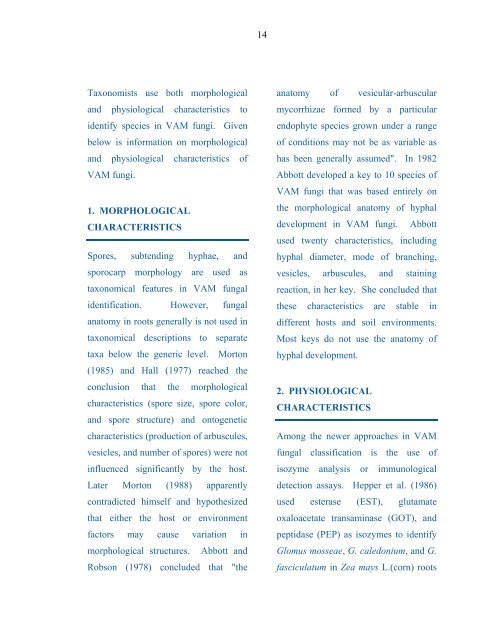Taxonomy and Ecology Of Inland Sand Dune ... - Mycorrhizae
Taxonomy and Ecology Of Inland Sand Dune ... - Mycorrhizae
Taxonomy and Ecology Of Inland Sand Dune ... - Mycorrhizae
Create successful ePaper yourself
Turn your PDF publications into a flip-book with our unique Google optimized e-Paper software.
14Taxonomists use both morphological<strong>and</strong> physiological characteristics toidentify species in VAM fungi. Givenbelow is information on morphological<strong>and</strong> physiological characteristics ofVAM fungi.1. MORPHOLOGICALCHARACTERISTICSSpores, subtending hyphae, <strong>and</strong>sporocarp morphology are used astaxonomical features in VAM fungalidentification. However, fungalanatomy in roots generally is not used intaxonomical descriptions to separatetaxa below the generic level. Morton(1985) <strong>and</strong> Hall (1977) reached theconclusion that the morphologicalcharacteristics (spore size, spore color,<strong>and</strong> spore structure) <strong>and</strong> ontogeneticcharacteristics (production of arbuscules,vesicles, <strong>and</strong> number of spores) were notinfluenced significantly by the host.Later Morton (1988) apparentlycontradicted himself <strong>and</strong> hypothesizedthat either the host or environmentfactors may cause variation inmorphological structures. Abbott <strong>and</strong>Robson (1978) concluded that "theanatomy of vesicular-arbuscularmycorrhizae formed by a particularendophyte species grown under a rangeof conditions may not be as variable ashas been generally assumed". In 1982Abbott developed a key to 10 species ofVAM fungi that was based entirely onthe morphological anatomy of hyphaldevelopment in VAM fungi. Abbottused twenty characteristics, includinghyphal diameter, mode of branching,vesicles, arbuscules, <strong>and</strong> stainingreaction, in her key. She concluded thatthese characteristics are stable indifferent hosts <strong>and</strong> soil environments.Most keys do not use the anatomy ofhyphal development.2. PHYSIOLOGICALCHARACTERISTICSAmong the newer approaches in VAMfungal classification is the use ofisozyme analysis or immunologicaldetection assays. Hepper et al. (1986)used esterase (EST), glutamateoxaloacetate transaminase (GOT), <strong>and</strong>peptidase (PEP) as isozymes to identifyGlomus mosseae, G. caledonium, <strong>and</strong> G.fasciculatum in Zea mays L.(corn) roots


